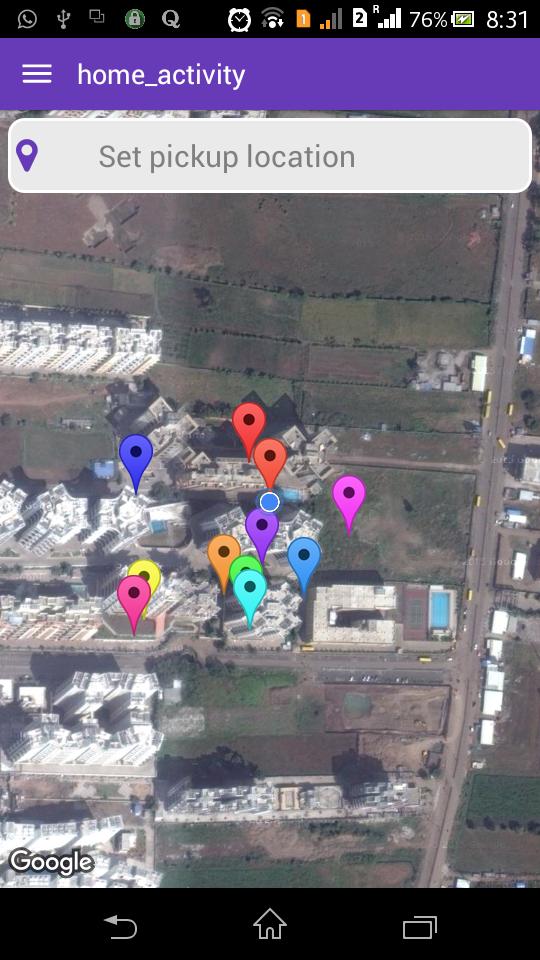I have an application with three tabs.
Each tab has its own layout .xml file. The main.xml has its own map fragment. It's the one that shows up when the application first launches.
Everything works fine except for when I change between tabs. If I try to switch back to the map fragment tab, I get this error. Switching to and between other tabs works just fine.
What could be wrong here?
This is my main class and my main.xml, as well as a relevant class that I use ( you will also find the error log at the bottom )
main class
package com.nfc.demo;
import android.app.ActionBar;
import android.app.ActionBar.Tab;
import android.app.Activity;
import android.app.Fragment;
import android.app.FragmentTransaction;
import android.os.Bundle;
import android.widget.Toast;
public class NFCDemoActivity extends Activity {
public void onCreate(Bundle savedInstanceState) {
super.onCreate(savedInstanceState);
ActionBar bar = getActionBar();
bar.setNavigationMode(ActionBar.NAVIGATION_MODE_TABS);
bar.setDisplayOptions(0, ActionBar.DISPLAY_SHOW_TITLE);
bar.addTab(bar
.newTab()
.setText("Map")
.setTabListener(
new TabListener<MapFragment>(this, "map",
MapFragment.class)));
bar.addTab(bar
.newTab()
.setText("Settings")
.setTabListener(
new TabListener<SettingsFragment>(this, "settings",
SettingsFragment.class)));
bar.addTab(bar
.newTab()
.setText("About")
.setTabListener(
new TabListener<AboutFragment>(this, "about",
AboutFragment.class)));
if (savedInstanceState != null) {
bar.setSelectedNavigationItem(savedInstanceState.getInt("tab", 0));
}
// setContentView(R.layout.main);
}
@Override
protected void onSaveInstanceState(Bundle outState) {
super.onSaveInstanceState(outState);
outState.putInt("tab", getActionBar().getSelectedNavigationIndex());
}
public static class TabListener<T extends Fragment> implements
ActionBar.TabListener {
private final Activity mActivity;
private final String mTag;
private final Class<T> mClass;
private final Bundle mArgs;
private Fragment mFragment;
public TabListener(Activity activity, String tag, Class<T> clz) {
this(activity, tag, clz, null);
}
public TabListener(Activity activity, String tag, Class<T> clz,
Bundle args) {
mActivity = activity;
mTag = tag;
mClass = clz;
mArgs = args;
// Check to see if we already have a fragment for this tab,
// probably from a previously saved state. If so, deactivate
// it, because our initial state is that a tab isn't shown.
mFragment = mActivity.getFragmentManager().findFragmentByTag(mTag);
if (mFragment != null && !mFragment.isDetached()) {
FragmentTransaction ft = mActivity.getFragmentManager()
.beginTransaction();
ft.detach(mFragment);
ft.commit();
}
}
public void onTabSelected(Tab tab, FragmentTransaction ft) {
if (mFragment == null) {
mFragment = Fragment.instantiate(mActivity, mClass.getName(),
mArgs);
ft.add(android.R.id.content, mFragment, mTag);
} else {
ft.attach(mFragment);
}
}
public void onTabUnselected(Tab tab, FragmentTransaction ft) {
if (mFragment != null) {
ft.detach(mFragment);
}
}
public void onTabReselected(Tab tab, FragmentTransaction ft) {
Toast.makeText(mActivity, "Reselected!", Toast.LENGTH_SHORT)
.show();
}
}
}
main.xml
<?xml version="1.0" encoding="utf-8"?>
<LinearLayout xmlns:android="http://schemas.android.com/apk/res/android"
android:layout_width="match_parent"
android:layout_height="match_parent"
android:orientation="vertical" >
<fragment
xmlns:android="http://schemas.android.com/apk/res/android"
android:id="@+id/mapFragment"
android:name="com.google.android.gms.maps.MapFragment"
android:layout_width="match_parent"
android:layout_height="match_parent" />
</LinearLayout>
relevant class ( MapFragment.java )
package com.nfc.demo;
import android.app.Fragment;
import android.os.Bundle;
import android.view.LayoutInflater;
import android.view.View;
import android.view.ViewGroup;
public class MapFragment extends Fragment {
@Override
public View onCreateView(LayoutInflater inflater, ViewGroup container,
Bundle savedInstanceState) {
super.onCreateView(inflater, container, savedInstanceState);
return inflater.inflate(R.layout.main, container, false);
}
public void onDestroy() {
super.onDestroy();
}
}
error
android.view.InflateException: Binary XML file line #7:
Error inflating class fragment
at android.view.LayoutInflater.createViewFromTag(LayoutInflater.java:704)
at android.view.LayoutInflater.rInflate(LayoutInflater.java:746)
at android.view.LayoutInflater.inflate(LayoutInflater.java:489)
at android.view.LayoutInflater.inflate(LayoutInflater.java:396)
at com.nfc.demo.MapFragment.onCreateView(MapFragment.java:15)
at android.app.Fragment.performCreateView(Fragment.java:1695)
at android.app.FragmentManagerImpl.moveToState(FragmentManager.java:885)
at android.app.FragmentManagerImpl.attachFragment(FragmentManager.java:1255)
at android.app.BackStackRecord.run(BackStackRecord.java:672)
at android.app.FragmentManagerImpl.execPendingActions(FragmentManager.java:1435)
at android.app.FragmentManagerImpl$1.run(FragmentManager.java:441)
at android.os.Handler.handleCallback(Handler.java:725)
at android.os.Handler.dispatchMessage(Handler.java:92)
at android.os.Looper.loop(Looper.java:137)
at android.app.ActivityThread.main(ActivityThread.java:5039)
at java.lang.reflect.Method.invokeNative(Native Method)
at java.lang.reflect.Method.invoke(Method.java:511)
at com.android.internal.os.ZygoteInit$MethodAndArgsCaller.run(ZygoteInit.java:793)
at com.android.internal.os.ZygoteInit.main(ZygoteInit.java:560)
at dalvik.system.NativeStart.main(Native Method)
Caused by: java.lang.IllegalArgumentException:
Binary XML file line #7: Duplicate id 0x7f040005, tag null, or
parent id 0xffffffff with another fragment for
com.google.android.gms.maps.MapFragment
at android.app.Activity.onCreateView(Activity.java:4722)
at android.view.LayoutInflater.createViewFromTag(LayoutInflater.java:680)
... 19 more


